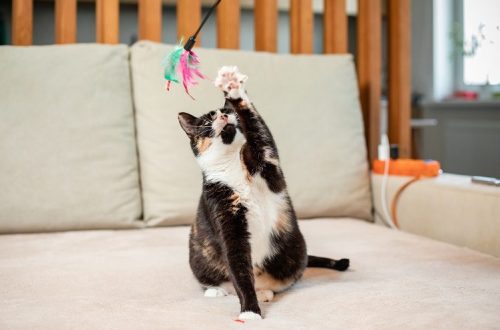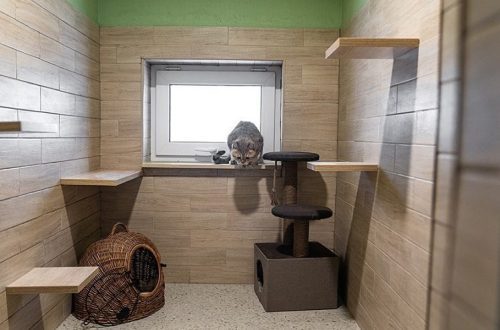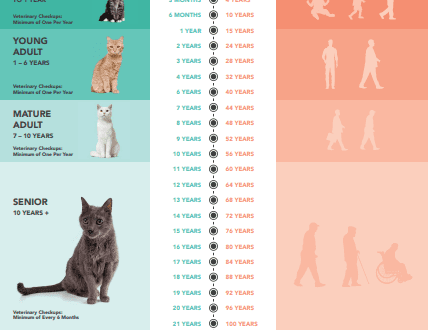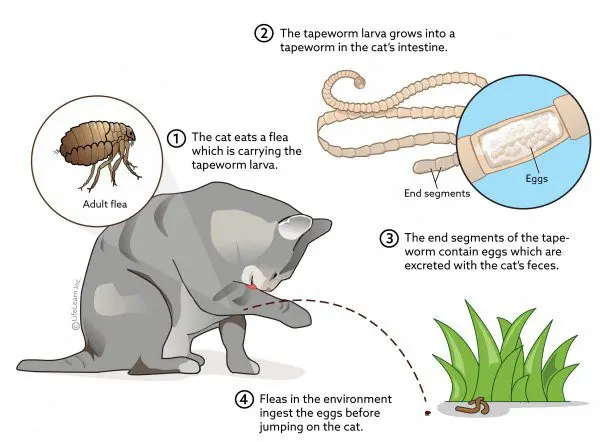
Worms in cats and cats
Contents
- Causes of worms in cats and cats
- Why are worms dangerous for cats?
- Symptoms of worms in cats
- Types of worms in cats and their symptoms
- Diagnosis of helminthic invasions
- Treatment of worms in cats
- Prevention of helminthiasis
- What cat worms can be transmitted to humans
- How to give a cat deworming medicine
- How to rid a cat of worms
- When not to deworm
- Is it possible to use folk remedies for worms in cats
- When to start fighting worms
Causes of worms in cats and cats
The main reason for the appearance of worms in mustachioed pets is the ingestion of parasite eggs into the body of cats. This can happen in the following ways:
- eating fish and meat products without prior heat treatment;
- communication with other representatives of the cat family (as well as canine) – carriers of worms;
- through insects – fleas, flies, mosquitoes;
- through rodents (helminth eggs may be on their skins);
- quenching thirst from a dirty reservoir;
- through the owner’s shoes;
- “picking up” eggs from grass, earth and other surfaces.
Note: kittens can become infected with helminths from their mother through milk or even in utero, so it is important to deworm cats in a timely manner before pregnancy.
Scheme of infection of a cat with the most common worms – roundworms, the roundworm genus
Why are worms dangerous for cats?
Developing in the body of a cat, worms cause great harm to the body of the animal. Firstly, they injure the mucous membrane of the digestive tract mechanically – they gnaw and pierce the intestinal walls with their spikes and teeth. Penetrating into the organs, they disrupt the structure of tissues and cells, limiting their functional activity. Sometimes the worms multiply to such an extent that they block the lumen of the small intestine, causing it to become blocked.
Damaged tissues of organs in which parasites live gradually decompose. The released toxic compounds are carried by the blood stream, leading to poisoning of the entire body of the animal. In addition, the worms themselves release toxins in the process of life and during decomposition after death within the body.
In the presence of worms in a cat, the immune system suffers greatly. A weakened pet is not able to fight other infections, which is the reason for the development of various bacterial, viral and fungal diseases.
In the case of abundant reproduction of worms, the psyche of the animal also undergoes significant changes. Constant itching, pain and other sensations lead to the fact that the cat becomes nervous and irritable, her sleep is disturbed and her appetite disappears.
Symptoms of worms in cats
What signs can be suspected of the presence of worms in cats? First of all, the owner should pay attention to the following symptoms:
A bloated belly in a cat can be a sign of a worm infestation.
- a change in eating behavior – the cat begins to eat more than usual, without gaining weight, or, on the contrary, refuses even her favorite food;
- violations of the digestive tract – difficult defecation alternates with diarrhea, there are pieces of undigested food in the feces, which indicates a failure in the enzyme system;
- anemia, weakness;
- the animal often licks the anus due to itching;
- the hairline grows dull, the hair falls out, becomes disheveled;
- mucous membranes acquire a yellow tint due to damage to the liver and gallbladder;
- the abdomen noticeably increases in volume;
- sometimes there is a cough (a sign of penetration of worms into the respiratory tract);
- stools may contain blood and mucus.
Attention: the owner must remember that similar symptoms can occur with other diseases. Giving a cat an antihelminthic without laboratory confirmation of helminthiasis can worsen the cat’s condition.
Types of worms in cats and their symptoms
In the body of cats, many types of worms can parasitize. What the most common cat helminths look like, their symptoms and ways of infection are in the table below.
Parasite
Looks like
Route of infection
Where does it live in the body
Symptoms
Ascaris (Toxocara) Thin, yellowish, up to 20 cm
Thin, yellowish, up to 20 cm
Eggs can be on any surface, in water. Possible intrauterine infection
GI
Eating disorders, bloated abdomen, anemia and others
Hepatic fluke Flat, about 3cm long
Flat, about 3cm long
Raw fish
Liver, bile ducts and bladder
Vomiting, diarrhea, refusal to eat
Cucumber tapeworm Jointed, flat, up to half a meter in length
Jointed, flat, up to half a meter in length
Fleas
GI
Diarrhea, vomiting, flatulence, refusal to eat, nervousness
Aleococci The larva looks like a bubble, with a diameter of 1 mm to 1 cm
The larva looks like a bubble, with a diameter of 1 mm to 1 cm
Feces of infected animals, rodents, ponds, grass
Liver, brain, lungs
depending on the affected organ. May be asymptomatic
Wide ribbon Flat, segmented, up to 1,5 m
Flat, segmented, up to 1,5 m
Raw fish, fresh water
Small intestine
Diarrhea, vomiting, flatulence, refusal to eat, nervousness
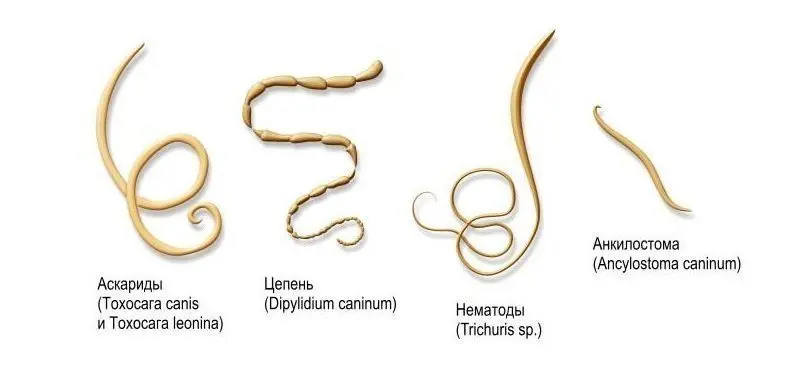
Diagnosis of helminthic invasions
It is not difficult to guess that a domestic cat has worms if they (or their particles) came out with feces or vomit. Otherwise, when the above symptoms appear, as well as periodically as a preventive measure, you should contact a veterinary clinic for diagnosis. It is best if the owner takes the animal directly to the veterinarian because stool alone is not enough to detect parasites in most cases. This may be due to both the localization of helminths and their insufficient sexual maturity, when the worms are not yet able to lay eggs.
Blood will be taken from the pet for laboratory testing, if necessary, a sputum test will be prescribed. In some cases, the doctor may refer the cat for an X-ray examination of the lungs or an ultrasound of the liver and heart. In the process of identifying helminthiases, they are differentiated from diseases of internal organs, poisoning, and colds.
Treatment of worms in cats
Treatment of worms in representatives of the cat family is carried out in a complex manner and consists in solving several problems:
- destroy parasites;
- ensure their rapid removal from the animal;
- to detoxify the body;
- restore immunity and functional activity of damaged organs.
For this, anthelmintic drugs are used, which can be intended for both internal and external use. Means are produced in different forms: tablets for worms, suspension, injections, drops.
Oral dewormers for cats
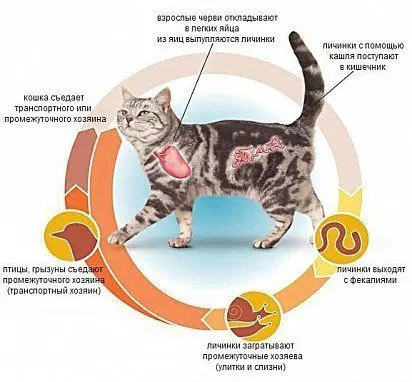
Cycle of lung helminths
Medicines for worms in cats, intended for internal use, have different effects on parasites. Some destroy the integumentary tissues and shells of eggs, others negatively affect the nervous structures, leading to paralysis of the helminth, and others disrupt metabolism. In addition, some drugs only work on adults, while others destroy larvae and eggs.
In accordance with the components that make up the drugs for worms, they are divided into broad-spectrum drugs and aimed at the extermination of only one type of helminths. The latter can be used only after an accurately established diagnosis.
Among the most common complex preparations for worms in cats are:
- Milbemax;
- Prasintel;
- Drontal;
- Prasicide;
- Fenasal.
During the disposal of a pet from worms, you need to carefully monitor its condition. The mass death of parasites can lead to severe intoxication of the cat, especially when there are a significant number of them. An animal weakened by helminths may experience vomiting and diarrhea. You can help your pet with absorbent means: you need to give activated charcoal, enterosgel or others.
Remedies for worms for external use
External preparations for helminths in cats are presented in the form of drops that are applied to the withers. These are: Bars, Profender, Droncid and others. These tools have both pros and cons. The former include ease of use, the main thing is that the animal cannot lick the place where the drops are applied. In addition, such a medicine destroys not only internal, but also external parasites – fleas and ticks, and also serves as a prevention of their occurrence.
Among the minuses, an insufficiently strong effect of the drug is noted, especially with a significant number of helminths. Drops are absolutely useless to use for helminthiasis caused by trematodes, the greatest effect is achieved if the disease in a cat is provoked by nematodes.
Injections from worms
In difficult cases, the veterinarian will prescribe a cat with worm injections – Ivomek or Ivermek. The procedures will need to be carried out in a clinic, since self-preparation of the solution can lead to errors in dosage and death of the animal.
Attention: the injection form of the drug is not a prophylactic.
Prevention of helminthiasis
To prevent the appearance of worms in cats, it is enough to adhere to the following preventive rules.
- Avoid contact with unfamiliar or infected animals.
- Upon arrival from the street, put shoes in a separate closed place, preventing the cat from sniffing them. Wipe the floor in the hallway several times a day using disinfectants.
- Regardless of whether the cat goes outside or not, treat it with external remedies for fleas and other parasites.
- Exclude raw fish from the diet of a mustachioed friend.
- Thoroughly and regularly wash the tray and food bowl.
What cat worms can be transmitted to humans

Take preventive measures when dealing with a cat, especially if you suspect the presence of worms
Although cats can host many types of helminths, not all of them are able to settle in the human body. A threat to the health of the host is, for example, flukes: hepatic, pulmonary and other species. These worms “settle down” in the internal organs of a person (liver, lungs), leading to a violation of their functions, tissue breakdown, hemorrhages, and even death.
Tapeworms, such as alveococcus, cucumber tapeworm, and others, can also lead to the death of the host. Anemia, allergies, blindness, death are the consequences of human infection from a cat with roundworms, nematodes.
Especially important is the prevention of infection of children in families where there are cats. It is necessary to explain to the child why it is impossible to kiss an animal, that after contact with it you need to wash your hands with soap and water, that stray kittens should not be stroked on the street, and so on.
How to give a cat deworming medicine
Many owners are faced with the problem of how to give a pill to a cat. Pets in every possible way resist the attempts of the owners to open their mouths and push an incomprehensible bitter thing into it. To prevent physical and moral injury on both sides, you can use a number of proven techniques:
- crush the tablet into powder and fall asleep in the mouth;
- dissolve the tablet in a small amount of water, draw it into a syringe and pour it into the cat’s mouth;
- apply a tablet dispenser.
See also: How to give a cat a pill to a cat.
How to rid a cat of worms
In order for the treatment of a pet from helminths to be most effective, firstly, you should carefully study the instructions for the drug. It is important to strictly observe the dosage recommended by the veterinarian or annotation (in the case of self-treatment). Before starting the treatment of helminthic invasion, the animal must be treated for external parasites.
Some cats manage to hold the pill in their mouth and then spit it out, so the owner must not only put the medicine in the pet’s mouth, but also make sure that it is swallowed.
In most cases, the medicine for worms is given to the cat twice with an interval of two weeks. This is due to the life cycle of parasites. With advanced disease, the doctor may prescribe a longer therapy.
After deworming, it is imperative to make sure that the activities were successful. This will require a second, control delivery of tests.
When not to deworm
There are several situations when it is necessary to wait a little with the treatment of cats for worms:
- serious condition of the pet;
- exacerbation of infectious diseases;
- cat pregnancy;
- lactation period;
- newborn kittens (usually age restrictions are indicated in the annotation to the drug).
Difficulties may also arise with deworming an aging cat. At this age, the animal should be treated for worms only in consultation with a specialist.
Is it possible to use folk remedies for worms in cats
Some owners – opponents of synthetic drugs – prefer to treat their pets for worms with folk remedies. For treatment, decoctions of wormwood, tansy, carrot juice in the form of enemas are usually used. Nevertheless, such measures are not very effective compared to pharmacological agents, and are quite acceptable as a preventive measure, as well as at the beginning of the disease, when there are not too many parasites.
When to start fighting worms
Fighting worms in cats should begin when the kittens are 3 weeks old. In the future, it is recommended to give anthelmintic drugs at least once every six months (better – once a quarter). Be sure to carry out deworming if pregnancy or vaccinations are planned.



